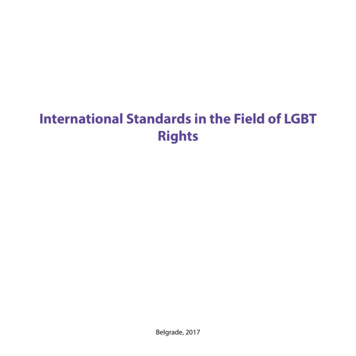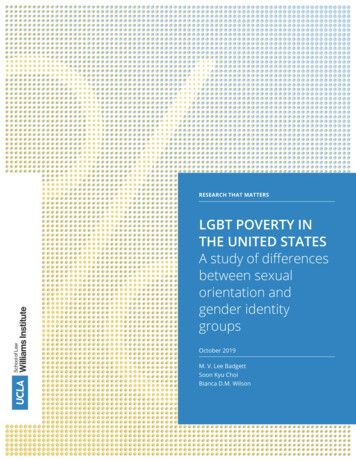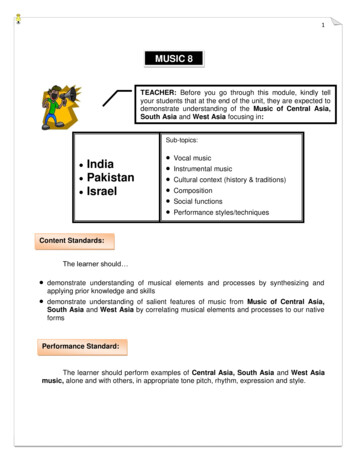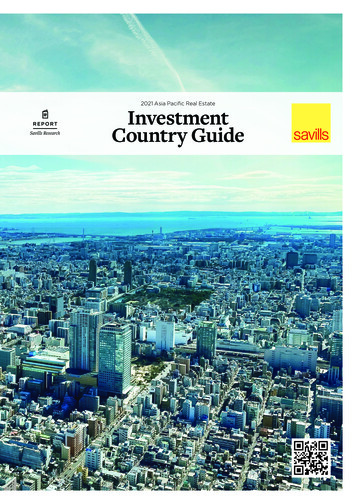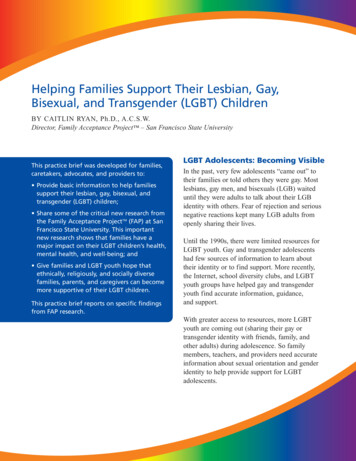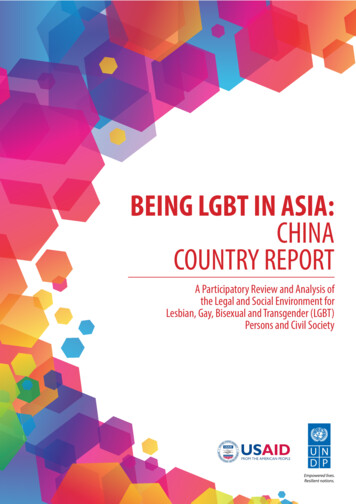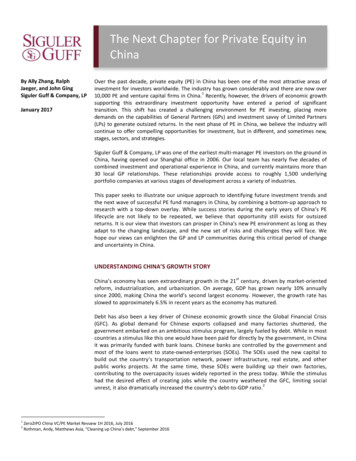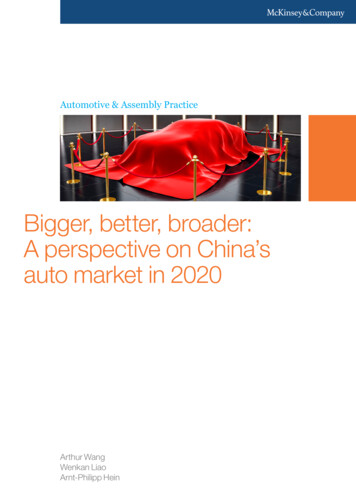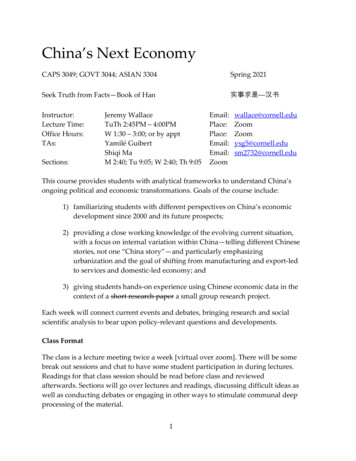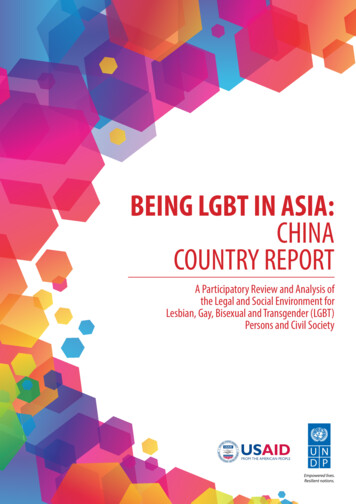
Transcription
BEING LGBT IN ASIA:CHINACOUNTRY REPORTA Participatory Review and Analysis ofthe Legal and Social Environment forLesbian, Gay, Bisexual and Transgender (LGBT)Persons and Civil Society
Proposed citation:UNDP, USAID (2014). Being LGBT in Asia: China Country Report. Bangkok.This report was technically reviewed by UNDP and USAID as part of the ‘Being LGBT in Asia’ initiative. It is basedon the observations by the author(s) of report on the China National LGBT Community Dialogue held in Beijingin August 2013, a follow-up China-Asia Transgender Roundtable held in Beijing in November 2013, conversationswith participants, and a desk review of published literature. The views and opinions in this report do not necessarily reflect official policy positions of the United Nations Development Programme or the United States Agency forInternational Development.UNDP partners with people at all levels of society to help build nations that can withstand crisis, and drive andsustain the kind of growth that improves the quality of life for everyone. On the ground in more than 170 countriesand territories, we offer global perspective and local insight to help empower lives and build resilient nations.Copyright UNDP 2014United Nations Development ProgrammeUNDP Asia-Pacific Regional CentreUnited Nations Service Building, 3rd FloorRajdamnern Nok Avenue, Bangkok 10200, ThailandEmail: aprc.th@undp.orgTel: 66 (0)2 304-9100Fax: 66 (0)2 280-2700Web: http://asia-pacific.undp.org/Design: Safir Soeparna/Ian Mungall/UNDP.
BEING LGBT IN ASIA:CHINA COUNTRY REPORTA Participatory Review and Analysis of the Legal andSocial Environment for Lesbian, Gay, Bisexual andTransgender (LGBT) Persons and Civil Society
CONTENTSACKNOWLEDGEMENTS 3ACRONYMS 5EXECUTIVE SUMMARY 7INTRODUCTION 17LGBT HISTORY AND ADVOCACY IN CHINA 18THE CHINA NATIONAL LGBT COMMUNITY DIALOGUE AND REPORT20BEING LGBT IN ASIA 21OVERVIEW OF LGBT RIGHTS IN CHINAINTERNATIONAL NORMS AND NATIONAL LAWS2222POLICIES 24CULTURAL AND SOCIAL ATTITUDES 27REGIONAL DIFFERENCES WITHIN CHINA 29IMPORTANT STATE ORGANS FOR THE PROTECTION OF LGBT RIGHTSPROTECTION OF LGBT RIGHTS IN CHINA3132EMPLOYMENT 32EDUCATION 34HEALTH 36FAMILY AFFAIRS 41MEDIA AND TECHNOLOGY 44COMMUNITY DEVELOPMENT 46CAPACITY OF LGBT ORGANIZATIONS IN CHINA49LEGAL STATUS 49HUMAN RESOURCES 50COMMUNICATION AND COORDINATION 51FUNDRAISING CHALLENGES 51BIBLIOGRAPHY 532 BEING LGBT IN ASIA: CHINA COUNTRY REPORT
ACKNOWLEDGEMENTSThis report documents the presentations and discussions from the three-day China National Lesbian, Gay, Bisexualand Transgender (LGBT) Community Dialogue, held 16–18 August 2013 with Day 1 in the United Nations (UN)compound in Beijing and Days 2 and 3 at a local hotel, as well from the November 2013 China-Asia TransgenderCommunity Roundtable also held in Beijing. Additional information was collected from interviews with a varietyof community participants and a desk review of published literature. Please note that due to constant and rapidchanges in LGBT community development in China, there may have been recent developments that have not havebeen included in this report at the time of publication.The participants in the China LGBT community dialogue served as the primary source for key parts of the report;however, the completion of this report was made possible by the support and contributions of many people andorganizations. We would like to thank them for providing their input, technical support and precious advice.UNDP would like to gratefully acknowledge the participants in the China National LGBT Community Dialogue whocame from all regions of China, including Shanghai, Beijing, Guangzhou, Tibet, Dalian, Chengdu, Jiangxi, Qinghai,Shandong, Xinjiang, and Yunnan for their participation and for providing valuable input for this report. We wouldlike to thank Vu Anh Lieu, former LGBT Human Rights Officer from the UNDP Viet Nam Office, for being part of theDialogue and providing the perspective of the LGBT movement in his country.Special thanks to the following people for providing key reference materials and guidance during thedevelopment of the Dialogue and the report: Li Zhen, Executive Director of Evening Primrose Care Center; Bin Xu,Executive Director of Common Language and a ‘Being LGBT in Asia’ Technical Advisor; Beichuan Zhang, RetiredMedical Doctor of Qingdao Medical School; Xiaopei He, Executive Director of Pink Space; Ge Tong, Former Directorof Men’s Health Forum; Zhijun Hu, Director of PFLAG-China; Jiangang Wei, Director of Beijing Gender HealthInstitute; Lin Meng, Coordinator of the China Alliance of People Living with HIV/AIDS; Wenhui Liang from the LGBTStraight Alliance; Ying Xin and Stephen Leonelli, Current and former directors of the Beijing LGBT Center; XiaofeiGuo, Law Professor from China University of Political Science and Law; Dian Dian, Dana Zhang and Ana Huangfrom the Chinese Lala Alliance; Hui Jiang, Director of Aibai Culture and Education Center in Beijing; XiaodongWang, Director of Chengdu Tongle Health Consulting Center; Popo Fan, Independent Filmmaker; Joanna Cheung,Director of Pink Alliance (Hong Kong); Wei Wei, Sociology Professor from East China Normal University; TiechengMa, Director of Shenyang Health Consulting Services Center; Gaizi from Yunnan Parallel; Fox from SunflowerLGBT-Hangzhou; Xiangqi from the lesbian group Shanghai Nvai); Anke, Director of Beijing Lala Saloon; SammyWu, a transgender activist from Shanghai; and Feiyan Zhao, a transgender activist in mainland China. In addition,special credit goes to the Beijing Gender Health Education Institute, who we had the privilege of working with inorganizing the national LGBT dialogue.The following people invested a great deal of time and effort in creating this report: Fan Ding, as the originalreport writer; Wenxu Xu, former LGBT Human Rights Officer in UNDP China; Karen Liao, LGBT Human Rights Officerin UNDP China; Andrea Pastorelli, Policy Specialist - Poverty, Equity and Governance in UNDP China; Saurav JungThapa, Technical Officer - LGBT and Human Rights at the UNDP Asia-Pacific Regional Centre; our interns at UNDPChina (Siddarth De Souza, Mitchell Luo and Lee Ying Hui), as well as Andy Quan for editing the report and thetranslators.BEING LGBT IN ASIA: CHINA COUNTRY REPORT 3
ACKNOWLEDGEMENTSValuable comments and input on drafts of the report were provided by Thomas White, Deputy Director,Governance and Vulnerable Populations Office, USAID Regional Development Mission Asia (RDMA); Vy LamAmerican Association for the Advancement of Science Fellow, USAID; Maria Rendon-Labadan, Senior DevelopmentCounselor, Daniel Delk, Human Rights Officer, and Jason Park, Second Secretary, from the US Embassy in Beijing; aswell as Edmund Settle, Policy Advisor, Human Rights and Governance in UNDP APRC.The Dialogue partners would like to recognize the outstanding contribution of Qing Gu, Team leader, Poverty,Equity and Governance Team, UNDP China; Yuan Xiao, Programme Associate, Poverty, Equity and GovernanceTeam, UNDP China; and Li Zhou, former LGBT and Human Rights Technical Officer, UNDP Asia-Pacific RegionalCentre in Bangkok for ensuring the Dialogue was a success. Our thanks and gratitude also to Li Zhen whofacilitated the meeting. A final thanks to the steering committee members who provided technical supportthroughout the process: Bin Xu, Li Zhen, GeTong, Xiaopei He, Jiangang Wei, and Beichuan Zhang. Our thanks andgratitude to One Plus One (Beijing) Disabled Person’s Culture Development Center for providing the meetingrapporteurs.4 BEING LGBT IN ASIA: CHINA COUNTRY REPORT
ACRONYMSAIDS Acquired Immune Deficiency SyndromeCCM Country Coordinating MechanismCCMD Chinese Classification of Mental DisordersCDC Centre for Disease ControlCSRES Civil Service Recruitment Examinations StandardCSO Civil Society OrganizationCBO Community Based OrganizationFtM / MtF Female-to-Male (transgender person) / Male-to-Female (transgender person)HIV Human Immunodeficiency VirusHRT Hormone Replacement TherapyLGBT Lesbian, Gay, Bisexual, and TransgenderMoCA Ministry of Civil AffairsMoH Ministry of HealthMoPS Ministry of Public SecurityMoJ Ministry of JusticeMSM Men Who Have Sex with MenMB Money BoyNPC National People’s CongressNCAIDS National AIDS ProgrammeNGO Non-Governmental OrganizationNHFPC National Health and Family Planning CommissionOSF Open Society FoundationPLHIV People Living with HIVSOGI Sexual Orientation and Gender IdentitySRS Sex Reassignment SurgeryUNDP United Nations Development ProgrammeUNAIDS The Joint United National Programme on HIV/AIDSUPR Universal Period ReviewUSAID United States Agency for International DevelopmentBEING LGBT IN ASIA: CHINA COUNTRY REPORT 5
EXECUTIVE SUMMARYBeijing IDAHOT (International Day against Homophobia and Transphobia) campaign at the Temple of HeavenBACKGROUNDThis report documents the presentations and discussions from the China National Lesbian, Gay, Bisexual andTransgender (LGBT) Community Dialogue (16–18 August 2013, Beijing), the Asia-China Transgender CommunityRoundtable (11 November 2013, Beijing), as well as additional desk research.The China LGBT Community Dialogue brought together participants from all over Mainland China (not includingHong Kong, Macau or Taiwan). Approximately 60 people participated in Day 1 of the Dialogue from 40 institutionsand organizations, representing the full range of China’s LGBT community alongside representatives of the centralgovernment, the court system, universities, legal experts and legal-aid organizations and a broad range of civilsociety organizations. Over 140 participants took part in the next two days of Dialogue from a larger numberof NGOs and CBOs from all over China. Ten transgender participants from across China and five transgendercommunity experts from Hong Kong SAR, India, Nepal, the Philippines and Thailand too part in the China-AsiaTransgender Community Roundtable. The Dialogue and Roundtable were jointly convened by the United NationsDevelopment Programme (UNDP) and the United States Agency for International Development (USAID).The Dialogue generated a comprehensive overview of the social, cultural and legal environment where ChineseLGBT people live and LGBT NGOs operate and included in-depth discussions on LGBT rights in China in the areasof: health, education, family, media, community development, employment and the law.BEING LGBT IN ASIA: CHINA COUNTRY REPORT 7
EXECUTIVE SUMMARYThis report is a product of a broader initiative entitled ‘Being LGBT in Asia: A Participatory Review and Analysisof the Legal and Social Environment for Lesbian, Gay, Bisexual and Transgender (LGBT) Persons and Civil Society.’Launched on International Human Rights Day, 10 December 2012, ‘Being LGBT in Asia’ is a first-of-its-kind Asiawide learning effort undertaken with Asian grassroots LGBT organizations and community leaders alongsideUNDP and USAID. With a focus on eight participating countries – Cambodia, China, Indonesia, Mongolia, Nepal,the Philippines, Thailand and Viet Nam – the effort examines LGBT lived experiences from a development andrights perspective.‘Being LGBT in Asia’ has a number of objectives. It encourages networking between LGBT people across the region,building a knowledge baseline and developing an understanding of the capacity of LGBT organizations to engagein policy dialogue and community mobilization. Through this work, ‘Being LGBT in Asia’ promotes understandingof the inherent human rights of LGBT people and the stigma and discrimination they face. It also outlines practicalsteps toward LGBT-inclusive development work for UNDP and the UN system, USAID and the US Government andother development partners through this report and other social and multimedia products. Finally, this initiativedocuments and highlights the views generated by LGBT participants at national community dialogues, linkingstakeholders who are working to enhance LGBT human rights across Asia.FINDINGSThis report provides an overview of LGBT rights in China as broadly related to law, policy, social and culturalattitudes, and more specifically to employment, education, health, family, media and technology, and communitydevelopment. It identifies regional differences in LGBT acceptance and community development as well asimportant organizations working for the protection of LGBT rights.Laws:In the history of China homosexuality was never directly criminalized. From 1979 to 1997, an anti-hooliganism lawcriminalized male homosexuality in relation to sexual assault (forced anal sex with a minor). This law was oftenused to persecute or intimidate gay men in Mainland China. The law was finally abolished in 1997. It is worthnoting that the anti-hooliganism law was never applied to female homosexuality. This is partly due to the factthat in China’s traditional patriarchal society, sex without a male partner was not considered an actual sexual act(phallocentrism). Thus while lesbianism was never actively criminalized in China, this led to the almost completeinvisibility of lesbians and bisexual women. Existing anti-discrimination laws are focused on a narrow definitionof gender that includes women but excludes LBT people (e.g. lesbians, bisexual women, and transwomen). Samesex marriage is not legally recognized in China. LGBT individuals have been victims of violence, extortion, andrape. But they are often afraid or ashamed to report such crimes to law enforcement officials due to the fear ofridicule and discrimination. Same-sex rape is not an offense punishable by law. The civil rights of LGBT people arenot protected in a variety of areas, including adoption by same-sex couples, inheritance, joint property rights,cohabitation, and compensation in the case of divorce. Censorship laws explicitly ban homosexual content inany form in movies and television. This prevents a broader public discourse on LGBT people as well as sexual andgender identity.Policies:While there is no specific policy on LGBT people there have been a handful of positive policy changes relatedto sexual orientation and gender identity, mostly with regards to public health. In 2001, the Chinese Society ofPsychiatry commissioned a working group to study the psychology of gays and lesbians, and research findingsultimately led to the removal of homosexuality and bisexuality from the official list of mental disorders in the8 BEING LGBT IN ASIA: CHINA COUNTRY REPORT
EXECUTIVE SUMMARYChinese Classification of Medical Disorders 3rd Edition (CCMD-3).1 In 2012, the National Health and FamilyPlanning Commission (former Ministry of Health) changed the national blood donation policy from banning all“homosexual” donors to only “men who have sex with men.”2 Due to the AIDS epidemic, over the last 15 years theChinese Centre for Disease Control (CDC) and the National AIDS Programme (NCAIDS) have successfully lobbiedfor public health policies focused on men who have sex with men; however, broader sexual and reproductivehealth policies for LBT people remain weak, especially for transgender people. The National Health and FamilyPlanning Commission’s Sex Change Operation Technical Management Standard3 requires transgender individualsto be diagnosed as mentally ill by medical workers, prove the desire for a sex change for more than five years,and get consent from their family members before sex reassignment surgery is allowed. Finally, although itis possible to change their gender on identity documentations after they have completed sex reassignmentsurgery, transgender people encounter difficulties in retroactively changing their gender on previously obtainededucational certificates. Finally, legal registration of LGBT civil society organizations remains extremely difficult,especially at the Provincial level. This is the primary bottleneck for the development of the LGBT community.Employment:Workplace discrimination based on sexual orientation and gender identity is common and is not prohibited by anylaw or national regulation. As such, LGBT individuals, particularly transgender people, suffer discrimination in theworkplace or find challenges securing a job. Many choose not to be open about their sexual orientation or genderidentity. A survey of 2161 LGB Chinese people conducted in 2013 showed that 47.62 percent chose to remaincompletely secretive about their sexual orientation in the workplace.4 A number of organizations5 have begunworking with the private sector on LGBT-friendly employment and human resources (HR) policies but this type ofwork is still in its infancy in China.Education:Bullying of LGBT students and discrimination in educational settings is an issue of serious concern in China,especially in rural and less developed areas. According to a survey conducted by Aibai Culture and EducationCenter in 2012, 77 percent respondents have encountered bullying on basis of sexual orientation or genderidentity with a further 59 percent reporting negative consequences on their school performance as a resultof bullying.6 The Chinese educational curriculum lacks information on sexual orientation and gender identity,because overall sexuality is considered a sensitive issue. Where sex education is available, the teachings alwaysfocus on standard hetero-normative frameworks, or often promote sexual abstinence, sometimes teaching thepathologization of homosexuality.Health:Health is a particular area of concern for LGBT people in China. A growing AIDS epidemic disproportionatelyaffects gay men, other men who have sex with men (MSM), and transgender people. Gay men and transgenderpeople living with or affected by HIV experience double stigma and discrimination for both their sexual123456Wan, Yanhai. Chinese Homosexuals Move Toward Normalcy. (中国同性恋走向正常) Aizhixing Research Institute, 2001.Ministry of Health Removes Ban on Lesbians from Donating Blood. Netease news, available in Chinese at ml, 9 July 2012.Sex Change Operations and Technology Management Standards. Health Office of Medical Affairs No. [2009]185. Available in Chinese athttp://baike.baidu.com/view/3140460.htmOnline Survey Report on the Work Environment for China’s LGBT Community. Aibai Culture and Education Center, May 2013. See http://www.aibai.com/ebook/library/ebook aibai/download/2013/8/16/online survey report on the work environment for chinas lgbtcommunity en.pdfIncluding Community Business, Am Cham Shanghai, Pink Dot and the Beijing LGBT Centre.Report of the Online Survey on Homophobic and Transphobic Bully at Education Institutions. Aibai Culture and Education Center, May 2012.Available at http://www.aibai.cn/ebook/library/ebook 20Bully(1).pdfBEING LGBT IN ASIA: CHINA COUNTRY REPORT 9
EXECUTIVE SUMMARYorientation/gender identity and their HIV status. They experience discrimination within the health care system, thecivil service (which still forbids people living with HIV to work for the State Civil Service System), and within theLGBT community itself. Other important health concerns include a rapid growth in sexually transmitted infections,and weak access to sexual and reproductive health as well as mental health services. The report highlights howthe health issues of lesbian and bisexual women are often overlooked and require more focused attention. Healthservices targeted at transgender people are particularly weak, with safe hormone replacement therapy and sexreassignment surgery remaining costly and difficult to access within the official health care system. Access topsychological and mental health is a major issue, considering the immense pressures of discrimination, stigma,social ostracism and internalized homophobia still present in China. With depression and suicidal tendencies notuncommon in the LGBT community, research and attention to the mental health of LGBT people is necessary.This is heightened in those LGBT people who are living with HIV and who face double stigma. Finally, ten yearsafter homosexuality was taken off the list of mental diseases in the 3rd Edition of the CCMD, many mental healthworkers, policy makers and educators are still unaware or unwilling to comply with this decision. These two factorscontribute to a situation where many mental health practitioners, often pushed by the families of LGBT people,recommend or impose ‘corrective treatment’ on LGBT people, sometimes involving involuntary committal topsychiatric hospital wards.Family:As the central component of social life, the family unit is extremely important in China. Traditional family structuresinvolve heterosexual marriage, childbearing, and a dominant parental role with little independence for childreneven after they have reached their adult age. However, rapid changes in society are affecting traditional familystructures. Younger generations are gaining more room and say in their personal lives, even though this hasn’tnecessarily led to more self-determination in the area of sexual orientation and gender identity. TraditionalConfucian notions, such as filial piety7, are still prevalent. Transgender individuals face the greatest challengesin their relationship with families, more so than gays and lesbians, because it is harder for one to hide genderexpression than it is to hide sexual orientation, and Chinese culture puts more emphasis on gender norms thanit does on sexual relationships. As same-sex marriage is not legal, many gay and lesbian individuals decide toenter “cooperation marriages” (known as Xing Shi Hun Yin in Chinese, or “marriage under cover”) with each other.The lack of rights protection for same-sex couples, including adoption of children or custody of children in casesof termination of previous heterosexual marriages, remains an issue to be addressed. Judicial sensitization isespecially needed to prevent unfair court rulings. Partly due to the One Child Policy, implemented since 1979,the younger generations face an increased pressure to bear children and to continue the family line. Under thispolicy, most families in urban areas of China are allowed to have only one child, who then is more likely to becomethe focus of parents’ investment, discipline and expectation compared to children growing up with siblings.Combined with elements in traditional Chinese culture that exceptionally value family honour, offspring rearingand filial piety, this policy often brings to the only child in the family tremendous pressure in all aspects of sociallife. This kind of pressure may typically include: excellence in school, success in career, entering into a traditionalheterosexual marriage, and the continuation of the family line. This pressure is especially burdensome for gaymen as the male heirs of their families. Because of this, many still choose to hide their sexual orientation and enterinto a heterosexual marriage, resulting in the suffering of their wives (known in Chinese as Tong Qi, “wife of a gayman”).7In Confucian philosophy, “filial piety” is the virtue of respect for one’s parents and ancestors. The term can also be applied to “generalobedience” and means to be good to one’s parents, to take care of one’s parents and to bring a good name to one’s family and ancestors.10 BEING LGBT IN ASIA: CHINA COUNTRY REPORT
EXECUTIVE SUMMARYSocial and cultural attitudes:Social and cultural attitudes towards homosexuality are changing gradually from traditional Confucian teachingsand patriarchal restrictions to more tolerant ones. Historically, Chinese society and culture did not show strongobjections against homosexuality. Chinese written history contains evidence of male same-sex desire andrelationships dating back to as early as 650 BC. While there are few records of women’s same-sex desire, historianYing Shao recorded relationships between women that resembled husband and wife in the 2nd centuryAD.8 Buddhism and Daoism, the two most influential religions in Chinese history do not explicitly condemnhomosexuality but generally do not encourage desire in any form. Overall, Chinese society and culture put moreemphasis on sexual roles rather than on sexual orientation.9 Still, public opinion regarding non-traditional sexualorientation and gender identity remains predominantly negative today. A 2012 opinion poll of 1502 residents inBeijing, Shanghai, and Guangzhou showed that only 31 percent of participants accept gays and lesbians, and only27 percent of survey participants indicated that there should be legal protections for sexual minorities.10 Given therelatively higher quality of education in these three cities as well as their metropolitan nature, numbers in supportof LGBT rights are likely to be even lower in other regions of China. In 2013, a survey of 3491 Chinese people fromcities throughout the country displayed similar results, with 68.5 percent of participants indicating that they couldnot accept homosexuality.11 Discrimination towards and disapproval from family, relatives and acquaintances ofLGBT people remain common as the latter are deemed to have deviated from traditional heteronormative familyvalues.Regional differences:Without protective national laws or a national political discourse on LGBT issues, there exist stark regionaldifferences in China in the development of LGBT communities, as well as in the levels of social acceptance towardsLGBT people. Large cities and regional urban hubs show the greatest development of LGBT communities andorganizations, as well as more tolerant social environments. This acceptance diminishes with the size of the city,leading to higher degrees of isolation of LGBT individuals in more remote rural areas. Data on LGBT organizationsand communities in rural areas and in the western parts of China (such as in the provinces or autonomous regionsof Tibet, Qinghai, Gansu, Xinjiang) is lacking. In addition to being considerably less developed than the easternparts of the country, most of these provinces or autonomous regions are home to the majority of China’s ethnicand religious minorities. It is clear that challenges faced by LGBT people of ethnic or religious minorities may bedifferent and in some cases greater compared to LGBT people in the rest of the country. That said, certain partsof Buddhist and Islamic teaching can be interpreted to favour sexual and gender non-conforming people. LGBTcommunity development in these regions is almost nonexistent, with only a few websites and online groupsand only two grassroots organizations focusing on HIV and sexual health for gay men. In general, the challengesfaced by LGBT people in Tibet, Xinjiang, and other western provinces or autonomous regions are compoundedby the complexities of religion, ethnic minority relations, poverty, rural cultural attitudes, and broader socioeconomic disparities.Governmental engagement:To date national and local governments have been largely silent on sexual orientation and gender identityrelated issues, taking a “not encouraging, not discouraging, not promoting” attitude. Currently no governmentdepartment or specific Ministry sees itself responsible for LGBT issues and this prevents a broader conversation891011Hinsch, Bret. Passions of the Cut Sleeve. University of California Press, 1990.A.L. De Silva. Homosexuality and Theravada Buddhism. See http://www.buddhanet.net/homosexu.htmSurvey for Homosexuality Acceptance: Beijing, Shanghai, Guangzhou Citizens’ Acceptance of Homosexuality. Available in Chinese at http://news.shangdu.com/401/20121102/13 5727705.shtml, 2 Nov 2012.Shanghai University of Communications Survey Indicates Traditional Ethics and Values Remain Common. Available in Chinese at http://xmwb.xinmin.cn/html/2013-12/25/content 10 5.htm, 25 Dec 2013.BEING LGBT IN ASIA: CHINA COUNTRY REPORT 11
EXECUTIVE SUMMARYwithin state organs. However, various government departments have shown interest in learning more aboutLGBT issues. In the near future, a number of state organs could potentially be engaged in LGBT issues at thenational level, including the National People’s Congress (NPC) Standing Committee, the Chinese People’s PoliticalConsultative Conference (CPPCC), the Central Political and Legal Affairs Commission of the Communist Partyof China, the Legislative Affairs Commission of the National People’s Congress, the Supreme People’s Court, theLegislative Affairs Office of the State Council, the Ministry of Civil Affairs, the Ministry of Education, the Ministry ofPublic Security, the Ministry of Justice, the Ministry of Human Resources and Social Security as well as the NationalHealth and Family Planning Commission. Branches of the above state organs are also recommended to beengaged at the provincial level, along with government-sponsored organizations such as the All China Women’sFederation, the All China Federation of Trade Unions and the Communist Youth League.Media and technology:Media and technology, especially social media, is playing an important role in allowing the LGBT community tonetwork, advocate and promote the work of many non-governmental organizations (NGOs) and communitybased organizations (CBOs). The Internet, particularly micro-blogs, is used to raise issues in the public sphere.However, there is a need for further training for LGBT organizations and individuals to become more media andtechnology savvy in advocating for LGBT equal rights. Broader public discourse of LGBT people and identities,as represented in mainstream media coverage, is still inadequate, often stigmatizing and based on commonstereotypes. This is made worse by the fact that censorship laws ban homosexual content in any form in moviesand television. This often has a negative impact on
UNDP partners with people at all levels of society to help build nations that can withstand crisis, and drive and sustain the kind of growth that improves the quality of life for everyone. On the ground in more than 170 countries and territories, we offer global perspective and local insight to help empower lives and build resilient nations.
